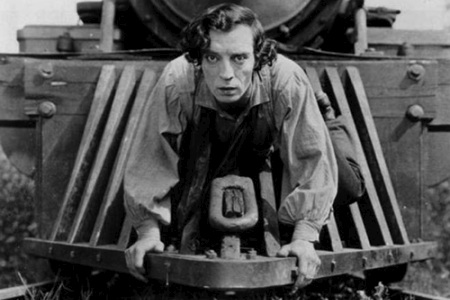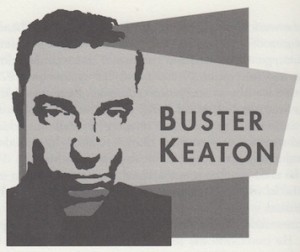Born: October 4, 1895, Piqua, KS
Died: February 1, 1966, Woodland Hills, CA
Keaton, even more than Chaplin, knew how to create a tragedy of the Object.
—André Bazin
Joseph Frank Keaton’s stony perfectionism is deeply rooted in his parents’ vaudeville act. The Three Keatons were regular faces performing with W.C. Fields, Bill “Bojangles” Robinson, Eddie Cantor, and master entertainer Al Jolson in theater houses at the turn of the century. From the age of four, he was trained in low comedy, mastering a routine with his father in which Buster would wait for a grievance to be inflicted upon him, retain his position with businesslike countenance, and proceed to hold this stolid expression while pummeling his father for laughs. Another physical routine had Keaton’s father disciplining the mischievous child by throwing him all over the stage, prompting the visiting magician Harry Houdini to nickname the kid “Buster.”
His mastery of the deadpan would get him plenty of work in Roscoe “Fatty” Arbuckle shorts from 1917 to 1920, beginning with The Butcher Boy (1917), the first of fifteen two-reelers with Arbuckle. His first starring role came in the feature-length The Saphead (1920). After Arbuckle was lured to another studio, Keaton was handed the camera and his first chance to direct without interference. Keaton took straight to the task, making his directorial debut with One Week (1920), a do-it-yourself homebuilder’s course performed in a twelve-minute one-reeler. After he slipped into a theater and saw people breaking up with laughter, Keaton was hooked on the movie business.
In the next eighteen months, he would produce the most amazing sequences of any comedian in film history. His inventive collection of silent classics, including Our Hospitality (1923), Sherlock, Jr. (1924) and The Navigator (1924), stands today as a record of his ability to mix trick photography, unprecedented stunt work and elaborate prop gags in a way never again matched on film.
While Keaton lacked the magical charm of Charlie Chaplin, he compensated with acrobatic stunts and wildly imaginative scenarios that entertained and stupefied audiences. Doing all of the hair-raising feats himself, Keaton framed himself against hostile landscapes of falling rocks, cars, boats, policemen, and armies. He opted for simple camera setups and long takes that make visible everything that happens. Keaton also established himself as an icon—the unwitting simpleton overrun by the modern mechanized world—repeatedly using his physical dexterity to overcome intractable machines. His pragmatic approach to solving his dilemmas was always understated by his stoic glance, and the effect was hilarious.
Keaton’s masterpiece, The General (1927), set during the Civil War, is best remembered for an elaborate chase involving a runaway train that set the pace of action thrillers for generations. Through ten features for United Artists, Keaton kept the innovations coming. Steamboat Bill, Jr. (1928) includes the famous scene in which a collapsing building narrowly misses Keaton; throughout the high-speed action of a twister attack on a small town, Keaton elevated his comedy beyond the sight gags of Chaplin and into the surreal world of dreams. His final self-produced film, The Cameraman (1928), was consistently used by major studios to train new cameramen and second-unit crews in the standards of comedic moviemaking.
In 1928, he signed a deal with MGM, but his fame dwindled. By 1932, he was divorced, reduced to costarring and alcoholic. Forced to direct films from others’ scripts rather than his own ideas, stifled and confused by the studio system, he lost the imagination of his early years, and his films amounted to nothing more than sappy and sentimental love stories. Because of his drinking, he was committed to a mental hospital in 1935; that same year MGM rehired him at a meager $100 a week to write gags on comedies like the Marx Brothers’ A Night at the Opera.
A brief tour with a live performance group called the Cirque Medrano put Keaton back on stage in Paris in 1947. His career was considered washed up until small turns in Billy Wilder’s Sunset Boulevard (1950) and Chaplin’s Limelight (1952) rekindled interest in him as an artist. A bizarre turn of events salvaged films that were thought lost; after actor James Mason purchased Keaton’s palatial mansion in the Hollywood hills, a secret stash of old films was discovered; the nitrate stock was preserved, and the films were shown to students and in festivals throughout the world. Keaton was hailed as a genius, a term he despised, and he received a special Oscar for his achievement in comedy films in 1954. Until his death at age seventy, he made cameo appearances in such star vehicles as Around the World in 80 Days (1956) and It’s a Mad, Mad, Mad, Mad World (1963).
His immortal comedies served as a model for cartoon animators—the Pink Panther was created in Keaton’s likeness—and contemporary filmmakers as diverse as Woody Allen and Hong Kong’s Jackie Chan have taken inspiration from Keaton, but no one has captured the impeccable timing and precise choreography of this comic artist, who was hopelessly ahead of his time.
To read all the republished articles from ‘The Film 100,’ go to Reintroducing the Film 100 here on Keyframe.





